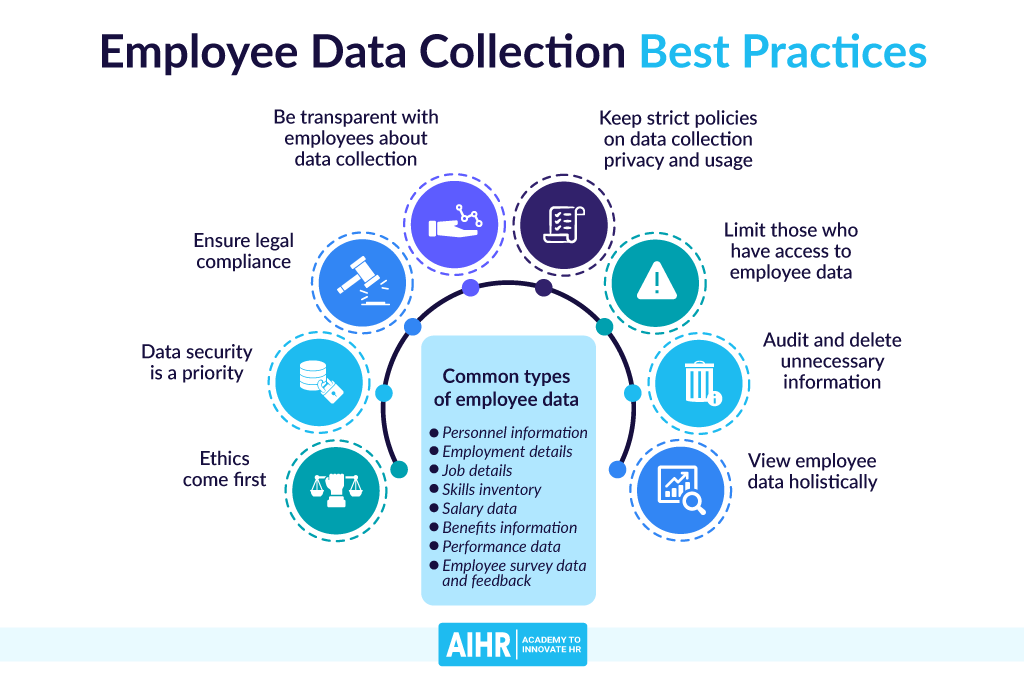Employee Data Collection in a Nutshell

Companies collect a variety of employee data to improve effectiveness, meet business objectives and reduce legal liabilities. With massive amounts of employee data collection happening, it can be easy for things to get out of control. Let’s have a look at types of employee data that are useful and the best practices for protecting, managing, and collecting employee data.
Contents
Data in HR and business
Types of employee data
Why is collecting employee data important?
Employee data collection best practices
Data in HR and business
Data is what the business world revolves around. Without data, organizations would not be able to make clear and strategic decisions. Human resources activities contribute a great deal of employee data which is useful to organizations. This data is then collected, organized, analyzed, and compared to measure success or failure.
HR professionals and business leaders then use the information to gain valuable insights, spot trends, and monitor the human side of doing business.
According to best-selling author Bernard Marr, “The part of business that has traditionally focused on softer elements like people, culture, learning and development, and employee engagement is becoming increasingly driven by hard numbers and data analysis.”
Employee data collection often takes place on a continual basis. For example, recruitment data that tracks applications and interviews, candidate diversity, and new hires over the course of a year. It is important to know what data to collect, the best data sources, and how to manage HR analytics effectively. Sometimes, it may take a little trial and error to get this right. However, it’s a good idea to start with what kinds of employee data can be collected.
Types of employee data
If you are new to collecting employee data, it’s normal to wonder what kinds of data can have the greatest impact on your human resources efforts. Here is a rundown of the employee information your HR department should be collecting and maintaining.
Personnel information: Make sure to create a secure digital file for each employee that includes information that often comes in handy. For example, their full name, date of birth, anniversary of hire, spouse or next of kin contact information, commuting preference, length of service, attendance records, and uniform and shoe sizes (if you supply these).
Employment details: Keep records of employment agreements, non-competes, hiring incentives, proprietary property for inventions, background check results, and other legal documents that spell out the terms of each individual’s employment with your organization.
Job details: You’ll also want to maintain careful records of job details, such as the job description, requirements, educational and experience needs. Ensure that these aspects are updated at least on an annual basis and compare them to what employees are actually doing at work.
Skills inventory: It is vital to maintain a complete inventory of employee skill sets so that you have available employees to take on new responsibilities. This also helps you to identify any skill gaps that can require additional training or recruiting new talent.
Salary data: Each year, salaries change with new job tasks, technology, and inflation. In order to keep your employees on board, it’s a good idea to keep track of salary data and how the salaries are changing. This can help your organization to remain competitive in a candidate-driven job market.
Benefits information: Keeping track of benefits information is part of the long-term plan to ensure that employees are making use of benefits like health insurance, paid time off, and employee training programs. You can obtain this data from plan administrators and use it to evaluate the value of benefits to employees each year.
Performance data: Many organizations track employee performance on a regular basis, whether it is through annual or quarterly performance appraisals, or in an ongoing process. Make sure you have a system for employees to set goals with the help of their managers and a way to track their progress through relevant metrics.
Employee survey data and feedback: A lot of employee data is generated directly from employees. Data collected through things like onboarding surveys, employee engagement surveys, and even exit survey findings can be valuable sources of information for making improvements and changes.
There are also other types of data that employers collect. For example, 87% of business leaders say their organization has collected COVID-19-related personal medical information such as vaccine status, COVID test results, or temperature checks. 67% of leaders have asked for personal information like sexual orientation, disability status, or ethnic identification to support a Diversity, Equity and Inclusion (DEI) program in the last year.
Why is collecting employee data important?
Employee data collection matters to all organizations, regardless of where it comes from. Why should you take the time to collect HR data? Here are three reasons:
- Creates a comprehensive picture of your workforce. You will have a good understanding of who works for you, for how long, what skills they have, how they perform, etc. All of this data informs the development of your short and long-term HR strategies. You can use this information to create a positive work environment, leading to higher productivity.
- Identifies human capital trends. By regularly collecting and analyzing employee data, you will be able to spot workplace and workforce trends. For example, you might notice that your employees often leave around the 2-year mark at your company. Understanding why this happens can open the doors to better retention programs.
- Better administrative processes gained. Employee data management software can make administrative processes more efficient. You can see at a glance what is going on in your workforce, what needs updating, what HR processes need to be managed and optimized, and more. For example, cost per hire data can be a good indicator of how efficient your recruitment efforts are and where you can improve your hiring process.
Employee data collection best practices
Employers face many challenges when collecting and analyzing employee data. There are some guidelines set forth by the federal government regarding what can be collected and for what purpose, including storage of this data.
What are some ways you can avoid any problems when collecting employee data?
Ethics come first.
What are your reasons for collecting specific types of data, and how will you use it? Have you had each employee sign a release form allowing you to collect their data? This can be relevant if you are using employee data management to determine productivity, employee wellness, and financial incentives.
Data security is a priority.
Make sure all HR staff, managers, and high-level administrators understand how to maintain safe employee records. Only store data that is required and do so using encryption.
Ensure legal compliance.
Be aware of the state, federal, and international laws that pertain to employee data collection and storage. For example, GDPR impacts businesses in the European Union but also companies that do business with entities in the EU, or have some employees based there.
Be transparent with employees about data collection.
Communicate to employees what kinds of information may be obtained, where it is stored, and how you’re using it to benefit them. Reference the current laws around this and educate them on the measures taken to protect their information.
This is especially important when collecting sensitive information like medical data. Research shows that only 1 in 4 employees are comfortable providing such data to their employer.
For example, you can create an information sheet and share it with employees in the onboarding process, or you can create a page on your company’s internal wiki.
A great way to show how important transparency is to you is to ask your employees for their input on what they would like to know about employee data collection at your organization.
Some organizations have an employee data bill of rights in place. This is a document that helps companies ensure that employee data is collected with the following in mind:
- Minimization – Collecting no more data than absolutely necessary to achieve an objective
- Purpose – Determining a legitimate purpose for the employee data use
- Fairness – Striving to eliminate different forms of bias
- Awareness – Informing employees about what data is collected and why
Keep strict policies on data collection privacy and usage.
Review and keep data collection policies up-to-date. Laws change, so this will ensure you remain compliant with sensitive data management.
Some of the federal laws that protect specific types of personal information in the US include:
- Health Insurance Portability and Accountability Act (HIPAA)
- Americans with Disabilities Act (ADA)
- Fair Credit Reporting Act (FCRA)
What’s more, different states might have stricter privacy laws. You need to stay on top of this to ensure compliance.
Limit those who have access to employee data.
The use of employee data should be defined by who needs it and for what business purpose. Use a data management system that allows for multiple user permissions.
Audit and delete unnecessary information.
Determine how long certain types of information is stored and when it should be deleted. For example, how long to store annual enrollment data or where to store employee records for the long-term.
View employee data holistically.
Several data points, when combined, can help validate and back up any HR trends and decisions to be made. Multiple sources of employee and workplace data show history and can help with spotting patterns.
An example of this may be the creation of a new department to expand operations in a new region. How well they grow, add new people, and generate new business can be indicators of success in HR areas.
A final word on employee data collection and use
Employers routinely compile certain information about their employees. Bear in mind that you must ensure compliance with state and federal laws when collecting and managing this data. Make sure to handle this employee data with security and purpose.
Always keep ethics and transparency top of mind in the employee data collection, sharing, and analysis process. Err on the side of being overly protective of this data rather than being casual about things.
Weekly update
Stay up-to-date with the latest news, trends, and resources in HR
Learn more
Related articles
Are you ready for the future of HR?
Learn modern and relevant HR skills, online













